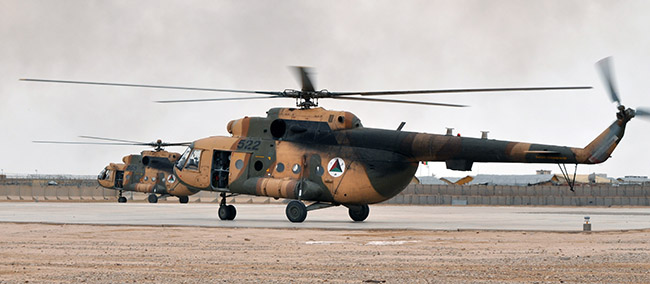In order to bolster the campaign against the insurgency in Afghanistan, strengthening Afghanistan’s air force is a key priority for the Afghan government and International allies. However, despite hundreds of millions of dollars being spent, the efforts for building an effective air force in the country has been lagging behind the stated objectives. This is while the role of well-functional air force, supporting Afghan National Security Forces (ANSF) in its anti-insurgency operations, is deemed as crucial for winning the war. According to US special inspector for construction of Afghanistan (SIGAR), the United States has spent more than $2.3 billion in the past five years for development of the Afghan Air Force (AAF). According to a SIGAR report, the United States has spent more than $1.8 billion for the development of the Afghan Air Force for the years 2012 to 2015 and more than 935 million dollars on provision of equipment and aircrafts for the force.
This is while there is still a long path ahead for the Afghan Air Forces (AAF) to become a fully functional air force, and provide the crucial capability of aerial firepower to ANSF. AAF has started playing a role in boosting the ANSF in the ongoing fight against the insurgent groups across the country. In 2015, when ANSF shouldered the burden of the war against the Taliban alone as the US-led NATO alliance ended its combat mission in Afghanistan, Afghanistan’s fledgling air force played a more significant role in the fight against the insurgent groups. Though it is far from being capable of fully providing the required support for the ground forces, its operations have been viewed as helpful for the government forces in the battle.
The government of Afghanistan has long been complaining from the US for not equipping the AAF with the required weaponry and the helicopters. However, there has been progress, though slower than expected, in equipping the Afghan air force with weapons and aircrafts. According to the US military, AAF now has 11 MI-35 helicopters, 52 Mi-17 helicopters, 16 MD-530 helicopters, 26 C-208 and four C-130 aircrafts. Recently, as the Indian PM visited Afghanistan, the country delivered three gunship helicopters to the Afghan government. The assistance was seen as an important move in the country’s security cooperation with Afghanistan and providing assistance to help the embattled Afghan army in the fight against the insurgents. President Ashraf Ghani has said that the US will deliver 20 more aircrafts to the Afghan Air Forces in weeks. However, AAF has particularly been suffering lack of skilled staff.
There have been long differences between the Afghan government and its international allies over building an effective force to support ANSF in the fight against the Taliban. Afghan leaders have long demanded combat aircrafts from the international community to help its ground forces in the fight against the insurgent groups. For the Afghan government forces, having airpower is meant survival in the war of attrition against the insurgents. Helping Afghan army and police forces to have the upper hand in the war, Afghanistan and the US need to speed up the efforts equip ANSF with the required planes and training its personnel. Therefore, Afghan previous government pushed for warplanes from the US and NATO for the past over a decade of the conflict.
Since the fall of the Taliban regime in 2001, last year (2015) was said to be the deadliest year for the Afghan government forces in the fighting against the Taliban and other militant groups.
Afghan officials believe lack of airpower was one of the key factors behind the high casualties of the Afghan security forces engaged in a far-reaching battle against the militants. There have been many cases of government forces being sieged by militants in remote areas across the country while the central and provincial military headquarters were unable of sending reinforcements. The same was with the battle in Sangin district of Helmand province. While security forces were surrounded by the Taliban, it took days for the government to send reinforcements to break the Taliban siege.
A high rate of attrition in the army is viewed as one of the biggest threats to strong Afghan military. And the high rate of ANSF casualties is one of the major factors behind soldiers deserting the army and police forces. It is believed that better provision of aerial support to the army units fighting the militants would drastically decrease the casualties of ANSF, which in turn lead into lower rate of desertion among the troops.
A highly capable air force in Afghanistan will be able to turn the tide of the battle in favor of the Afghan forces and help containing the insurgency.
Therefore, the Afghan government needs to make it a top priority to strengthen AAF, and convince the international community to do more in training its personnel and providing weaponry and aircrafts to the force. The national unity government needs to do more through diplomatic means to ease concerns of the neighboring countries over the future of Afghan military and air force capabilities, and improve security cooperation with the neighboring countries aimed at removing any existing distrusts. The national unity government has been more successful than the previous governments in persuading key international and regional partners to boost support for the Afghan army, particularly the country’s fledgling air force. The government should enhance efforts to persuade the major world and regional supporters of Afghanistan to speed up the efforts for building a sufficiently strong Afghan air force.

